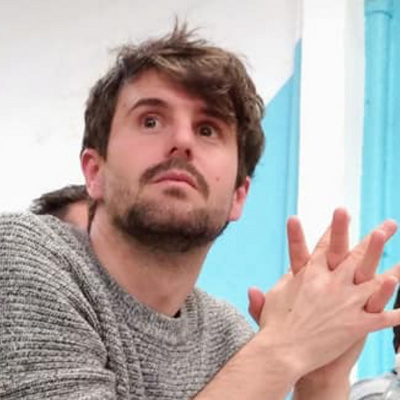The New Traditional Circus of Hermanos Castro in Chiloé
A magical Chilean island gives rise to a unique company that melds the circus traditions of new and old: the Circo Hermanos Castros. The Está Pasando Project’s Miguel Manzano recounts the story of the company’s creation—and how a Latin American circus family came together.
This is another special report from Está Pasando for CircusTalk. We continue in Chile, the first country on our journey of mapping Latin American circus through inclusion.
In our first collaboration, we were able to feature the wonderful insights of Maca Simonetti. A few weeks later, we shared with the community the documentary “The Dimensions of Juggling in Chile.” This is our third story, and I believe you’re going to enjoy it.
This story is about a crossroads that sometimes appears challenging, but in this case, it happened naturally. I’m talking about the encounter between traditional circus and contemporary circus. This is the story of a company that was born on a magical Chilean island and, unaware of the emerging new circus movement in the country, was founded as a circus from the past. A circus of humble tents. One that boasts only imagination and virtuosity. For years, they have traveled the Chiloé archipelago: the island of the sorcerers.
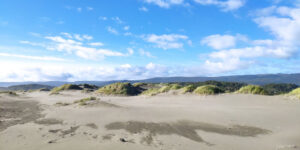
This is the story of the circus “Hermanos Castro.” And I’m going to start it from the end.
From Where I Write
Right now, I am in Argentina. We left Chile months ago. We traveled over 5000 km to get to where we are now. The journey continues, the circus doesn’t stop.
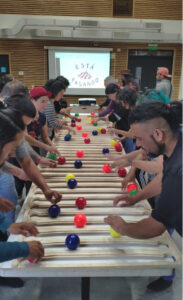
To be honest with you, we were on Chiloé five months ago. When we were there, it was to conduct a Functional Juggling seminar, which we organized in collaboration with an incredible cultural center called CECREA, dedicated solely to providing artistic activities for the children and teenagers of the area.
Initially, there wasn’t a large circus community on the island. At least, none that I knew of. Chiloé is an island in the Región de los Lagos. It’s an incredibly beautiful place, but it has a very small and scattered population. Just to give you an idea, public officials who work there receive an extra payment for the “isolation.” However—and this is one of the beautiful things about the project—a couple attended the seminar: Miguel and Amanda. He was a circus juggler, and she was a social worker. On the last day of the seminar, Miguel invited me to train with them and their company at a public sports complex in the city. So I went there, mostly out of curiosity.
I had a great morning, practicing lifts and sharing acro techniques with some fantastic artists who were eager to learn. During the time we spent training, they told me their respective stories, but since we left the island the next day, that whole experience got stored away in the recesses of my memory.
A few weeks ago, I told a group of friends the story of the small circus company from Chiloé. They were fascinated. And I thought, “Wait! This is a good story.” So now, I’m finally going to tell you the story of the Castro brothers.

Felipe Castro
Chiloé is an island known for its almost Jurassic, cold, and extremely beautiful landscape. But it’s also known because it was inhabited by The Brujos (it’s rumored that it still is). The Brujos are a culture of men with magical powers, who have a pact of silence, who live among us and continue to perform transformation rituals, giving rise to many dark and fascinating legends: sea creatures, specters, giant beasts, goblins, and a plethora of incredible local stories.
Felipe was born and raised on Chiloé, just like his father, grandfather, and great-grandfather. His connection to the circus began at a very young age, coincidentally, as the circuses that passed through his city would set up next to his house. This might seem like an anecdote, but after more than 50 interviews, you’d be surprised by the number of circus performers who became involved with the circus because “their house was next to where the circuses set up when they came to town.”
When he reached adulthood, Felipe left the island to study drama on the “mainland,” as there were no universities on the island. While studying theater, he discovered that one could learn circus arts without being from a circus family. At the drama school, he befriended Miguel Garay, the acrobatics teacher, who had experience working in circuses. So in 2010, Miguel invited Felipe and his friend/colleague Esteban Aránguiz on tour with Circo Fénix from Santiago all the way to Chilean Patagonia. There, they learned everything one could learn about the circus: from selling popcorn, setting up tents, and performing various acts to promoting the tour.

In 2013, Felipe returned to his island and founded a small circus association-school, where he teaches numerous artists to this day. In 2016, he decided to dream big and bought a tent for his little school: La Colorina. However, as the circus world is small and rumors spread quickly, Miguel Garay contacted him from China and proposed a different idea: instead of setting up a school, they should establish a traditional circus company together.
I wish I could tell you it was an immediate success, but that would be a lie. Beginnings are tough, and the first year was quite challenging. Fortunately, they already had a lot of experience, and along with his friend Esteban, his partner Maria Angeles “Yoyi,” and his brothers, they continued their adventure to this day.
Since there were several siblings, two of them twins, they decided to name themselves “Circo Hermanos Castro” (Castro Brothers Circus). And since 2016, they have been spreading their magic throughout the Chiloé archipelago.
Learning from Tradition
Perhaps what I’m about to tell you might seem somewhat irrelevant. However, I’d like us to share a perspective that goes far beyond the circus, so you can understand why I’m sharing this with you. This perspective reveals one of the driving forces behind the Está Pasando project, which relates to the human capacity to transmit living information.
In Steven Johnson’s book Emergent Systems, the importance of information exchange networks for learning and generating new ideas is discussed in-depth. It might seem obvious, but in a big city, there are more learning opportunities in any subject than in a remote village. Nowadays, information reaches everywhere instantly. This has fascinated us so much, having happened relatively recently, that sometimes we forget something very important: information, by itself, is not knowledge.
And this is where the story gets interesting.
In the circus, there are countless disciplines. I dare say there are as many as there have been restless, skillful, stubborn, and daring individuals throughout human history. The circus is full of such people. In fact, we might agree that if we were specifically looking for someone who fits that profile, for whatever reason, the best place to find candidates would be at a circus. When a crazy idea is executed in front of an audience, we call it an act. That act becomes a circus discipline when other people are willing to learn how to do it, sometimes on their own and sometimes guided by those who have done it before them.
This is a rather rudimentary summary of what might be one of the most perpetually debated topics in the circus: who, how, and when certain acts or disciplines were created. Personally, I don’t care much. I like to think that each act is an unlocking of human potential driven by the sheer desire to amaze.
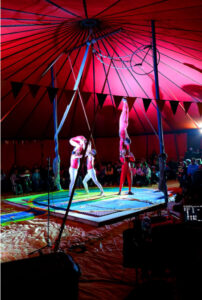
Some circus disciplines have become so popular that you can find them even in gyms in any small town. However, there are others that require studying in very specific schools abroad or are simply passed down within certain family lineages. Sometimes, forgotten disciplines become trends for a few years. I would love to map out this dispersion and fluctuation of ideas. But let’s return to the story.
Circo Hermanos Castro had been struggling to survive on the island of Chiloé for a year. Something wasn’t coming together. A piece was missing. An incentive. Something that would make them special. They spoke to Toni Pontito, a traditional circus clown who had made their tent. He decided to connect them with Don Vicente Ventura.
Vicente Ventura was a highly recognized circus artist in his time. And I say “his time” because he’s now 88 years old. Much of his family is involved in the circus and performs all over the world. However, no one wanted to continue with what was his great passion: the aerial perch.
I’ll tell you a secret that ties in with everything mentioned earlier: in Chile, outside of traditional circus tents, it’s impossible to learn classic aerial perch. I won’t extend this premise to all of South America, but it’s a discipline that isn’t taught in schools. It’s learned from those who know. From those who have done it, and unfortunately, they are becoming fewer and fewer.
But Don Vicente Ventura didn’t want his knowledge to be lost. So, he decided to share with the Castro Brothers everything he knew about the aerial perch technique and circus in general.
Now, Circo Hermanos Castro was a traditional circus, founded by individuals who didn’t come from circus families. Living information intertwined among people, places, and the right moments, allowing various disciplines to survive in that part of the world, far from the major centers of knowledge.
I like to think that each discipline is an idea that, from the moment it’s born, refuses to disappear and captivates those who bring it to the stage. Fascinating and inspiring other artists to further develop them. Surviving through us. And perhaps, that’s what we are: guardians of crazy ideas that exist solely to amaze us with what we’re capable of.
The Rest of the Crew
To me, a circus company is most similar to a pirate crew, minus the sabotage and violence. It might sound like an odd comparison, but I’m one of those millennials who grew up watchingOne Piece. I can’t help it. So, when Felipe told me his story, I decided he would be the leader of that pirate crew, the Luffy of this tale. Each of his companions would be a “nakama” of the crew, with a unique ability. And the Circo Hermanos Castro would be the pirate crew, raising the sails of the tent La Colorina, to delight the children of Chiloé, the island of the sorcerers.
So, I’m going to tell you how the crew was formed and what their abilities and superpowers are.
Let’s start with Esteban Aránguiz, also known as “Tony Tuto,” with whom Felipe began his circus adventures in Circo Fénix back in 2010. He is the current foreman, responsible for setting up the tent. He is also a base for hand-to-hand acrobatics and aerial perch. He was a direct apprentice of Don Vicente Ventura, which fills him with pride.
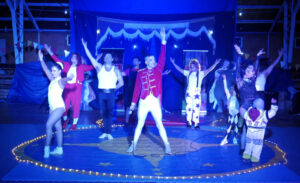
The Hermanos Castro company is named after Felipe’s actual brothers. As Lucas, the younger brother and magician, recounts, he was 14 years old when Felipe returned from his tour with Circo Fénix and convinced him to join the show with his magic tricks. Now the circus is his life, and I find it incredible what it must be like for your older brother to come home one day and whisk you into the circus, like a whirlwind, and before you know it, you’re a professional on stage, not only doing magic but also becoming the clown “Rubito.”
Maria de los Ángeles, better known as “Yoyi,” never envisioned a life in the circus. In fact, she never even considered a life on Chiloé, but destiny led her there. She was a dancer and choreographer and began training in Felipe’s classes because it seemed like a fun activity. Seven years later, she is one of the stars of the Hermanos Castros show, as well as Felipe’s wife and the mother of their two curious daughters. The older one, Frances, participates in the shows whenever she can and is very proud to be the clown “Frutillita” (Little Strawberry).

The story of Ierson Mora, “Payaso Morita,” is quite unique. Like Felipe Castro, he had an early connection to the circus because his grandmother used to wash and mend costumes for the circuses that came to town. This gave him VIP access during his childhood, and sometimes he was allowed to wander around the circus camp. He was captivated. He grew up and went into local commerce, but one day he fell ill and, upon recovering, decided that his life would revolve around the circus. He became a student in Felipe’s classes, and through that, he prepared himself to work in traditional circuses, where he learned all sorts of disciplines: the Wheel of Death, flying trapeze, trampoline, acrobatics, and ultimately, his favorite and most comprehensive: the “Tony,” or the traditional Chilean clown.
One of the most powerful parts of this story is how the circus has permeated the lives of the entire Castro family, from the siblings to their daughters, partner—and even their mother who, on a trip to Cuba, became fascinated by a circus discipline she saw there. She took some photos, and this allowed them to create an apparatus that I had never seen before and that I find extraordinary. They call it the “cuadrante-cervical”; I’m not sure of the English translation, but between Yoyi and Felipe, they crafted it and explored it until they developed an act that is unique throughout Chile.
Lastly, I’d like to share the story of the most recent members of this company, as their story inspired me to write this report.
Miguel Roa attended our Functional Juggling seminar and was the one who invited me to train with the company at the municipal sports complex. He is from Santiago, Chile, and rode his bike to take one of the ships that make the daily route to Chiloé Island. Like many others, the pandemic made him want to distance himself from large cities, so he sought a peaceful place in the south to pursue his other profession as a carpenter. He learned circus arts on the streets with the self-organized collective Las Sin Carpa, an anarchist group of multidisciplinary artists who share knowledge of all kinds. He learned juggling, acrobatics, and lifts, and also worked as a setup technician at various circus events in the country. He was part of a well-known underground circus company:Va Circo. And there, he began working with Jansi Silva.
Jansi, also known as “Tony Ramazzoti,” is an acrobat in the company but learned circus through a social project in his town, right on the streets of Santiago. There, he was exposed to multiple disciplines. He founded his own company and was able to pass on what he learned to the new generations in his neighborhood through another social circus project, where he became a teacher. Then, after the pandemic, he had to change professions. One day, Miguel Roa called him and said, “If you’re going to be a cook, you might as well come to this paradise and be happier.”
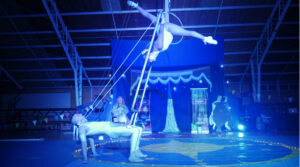
And that’s how Miguel and Jansi, the “Desequilibroders,” ended up in Castro, Chiloé. The rest was quite natural: one day they shared a training session with Hermanos Castro and have been part of the company ever since. But their role, unlike the other members, is that they bring the knowledge of urban circus movement from Santiago and infuse that new energy. They learn from the traditional and share the contemporary: from forms to techniques.
For me, that’s where the balance lies, and the true driving force of art as a tool for transformation and creation. In that flow of ideas that carve their path through different worlds.
The New Traditional Circus
A few years ago, there was a debate—one that might still be ongoing—wherein some traditional circus artists didn’t consider the new circus as “real circus.” They thought it was something else. For me, it’s not an engaging debate, so I don’t have much to contribute on the matter. What I do believe is that there are certain essential traits of traditional circus that continue to define it: the tents, the circus ring (one or several), the costumes, the technical acts interspersed with comedic ones, and so on. But above all, there’s something that isn’t seen on stage but remains very much present: circus families.
I’m fascinated by the concept of familial lineage as a model for transmitting knowledge and status. It’s something that has been lost in other professions but persists in the circus. Of course, it has lost some of its past strength, but remnants remain.
Currently, in Chile, there are more than 80 traditional circuses, and it’s estimated that around 6,000 people are professionally involved in this sector. In 2022, the Chilean government recognized the circus as part of the country’s intangible heritage. These figures are quite striking when compared to other Ibero-American places like Spain, where traditional circus is still present but doesn’t hold as much prominence or recognition.
When Circo Hermanos Castro began, they encountered resistance from some traditional circuses because they weren’t considered one of them. Gradually, they have shown that they keep the essence alive and make efforts to contribute to their region. They respect the core while also renewing and adapting.
If you think about it, what sets Circo Hermanos Castro apart from a traditional circus “of old”? It’s a circus that maintains the aesthetics, the structure of acts, the nearly forgotten disciplines, the tent, the group. But, above all, the family. This circus consists of Felipe and his brothers, who give it their name, as well as his wife and his best friend Esteban. And finally, his daughter Frances, who is already part of the performances and is being trained to continue this tradition. Some come and go. Some pass by, others stay. The tent of the Hermanos Castro is open to anyone who wants to experience the new traditional circus.
The only thing that sets the Castro brothers apart from traditional circuses is precisely their lineage. But every lineage has an origin. And I love to think that the era in which the “old-time circuses” were born isn’t a thing of the past. It’s still possible today. And here’s a clear example.
On the island of the sorcerers.

Images shared by Miguel Manzano and the Está Pasando project....
Do you have a story to share? Submit your news story, article or press release.


